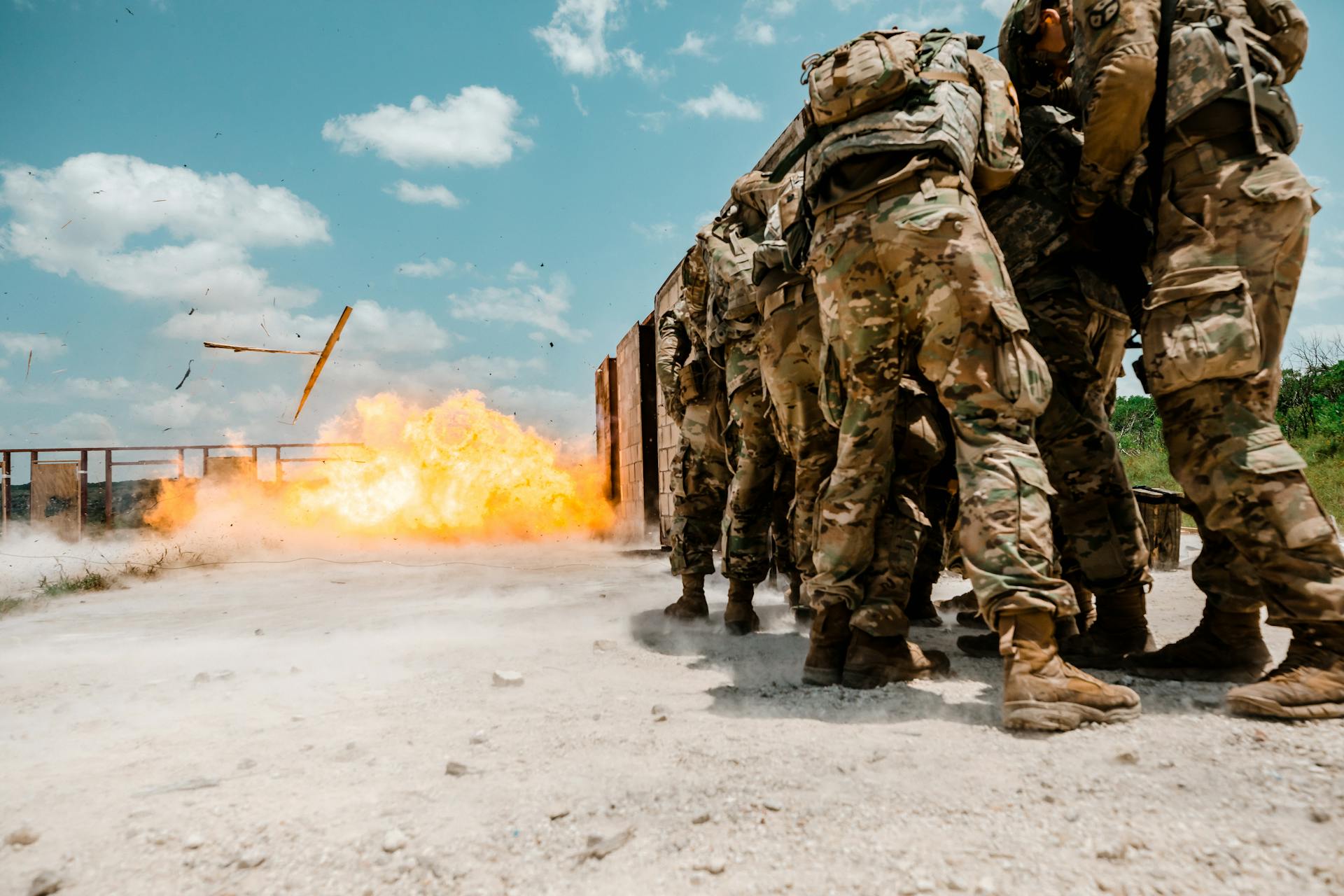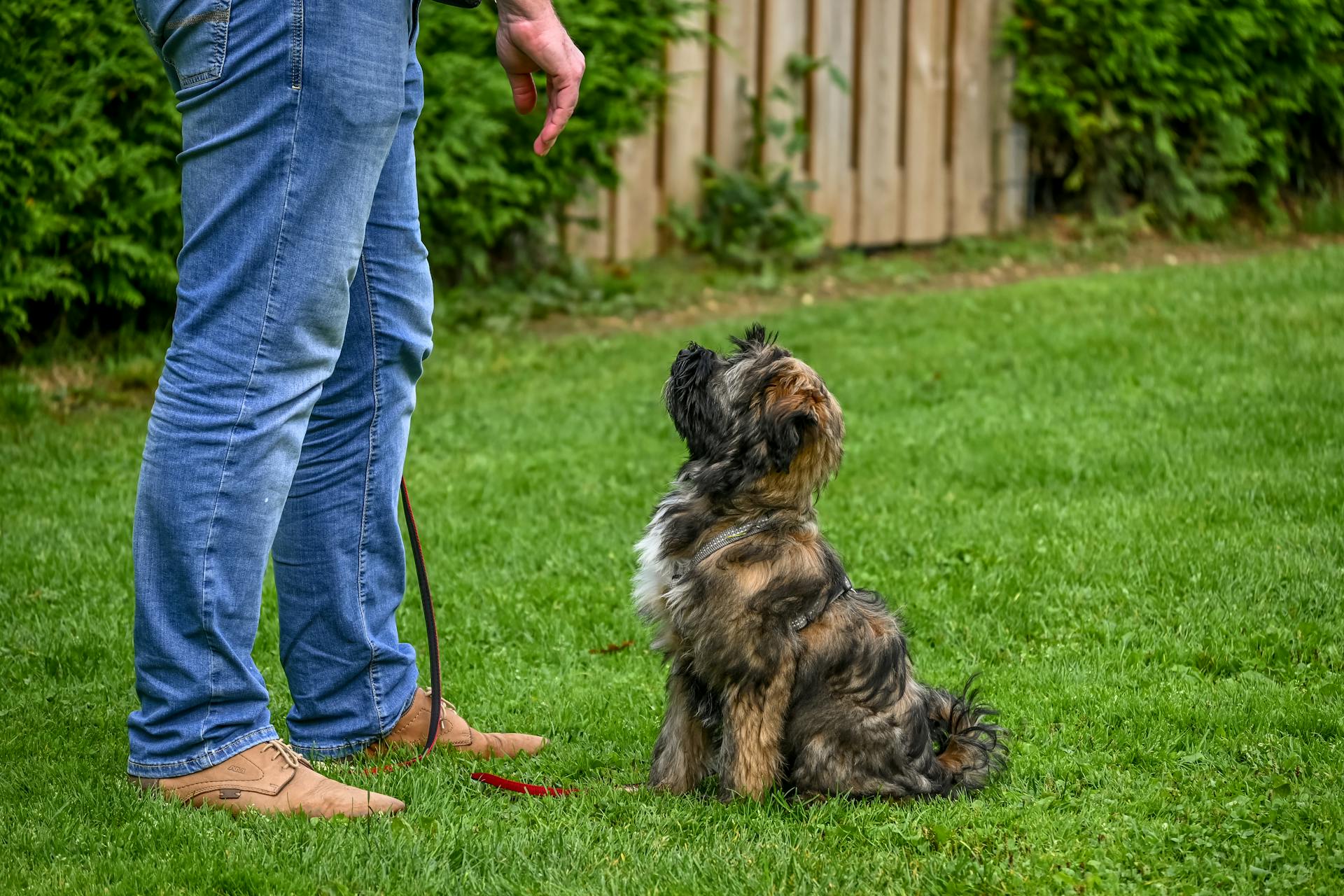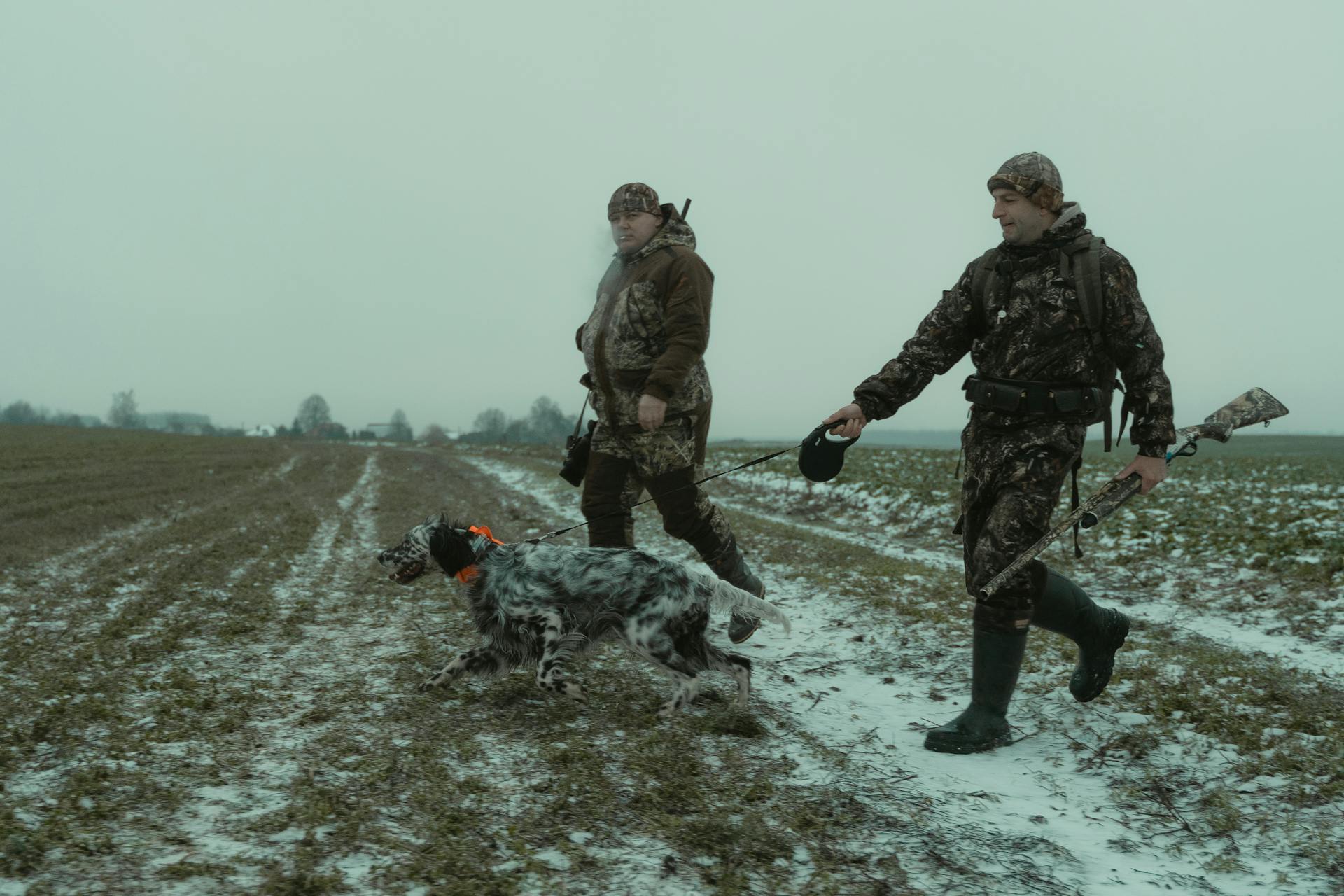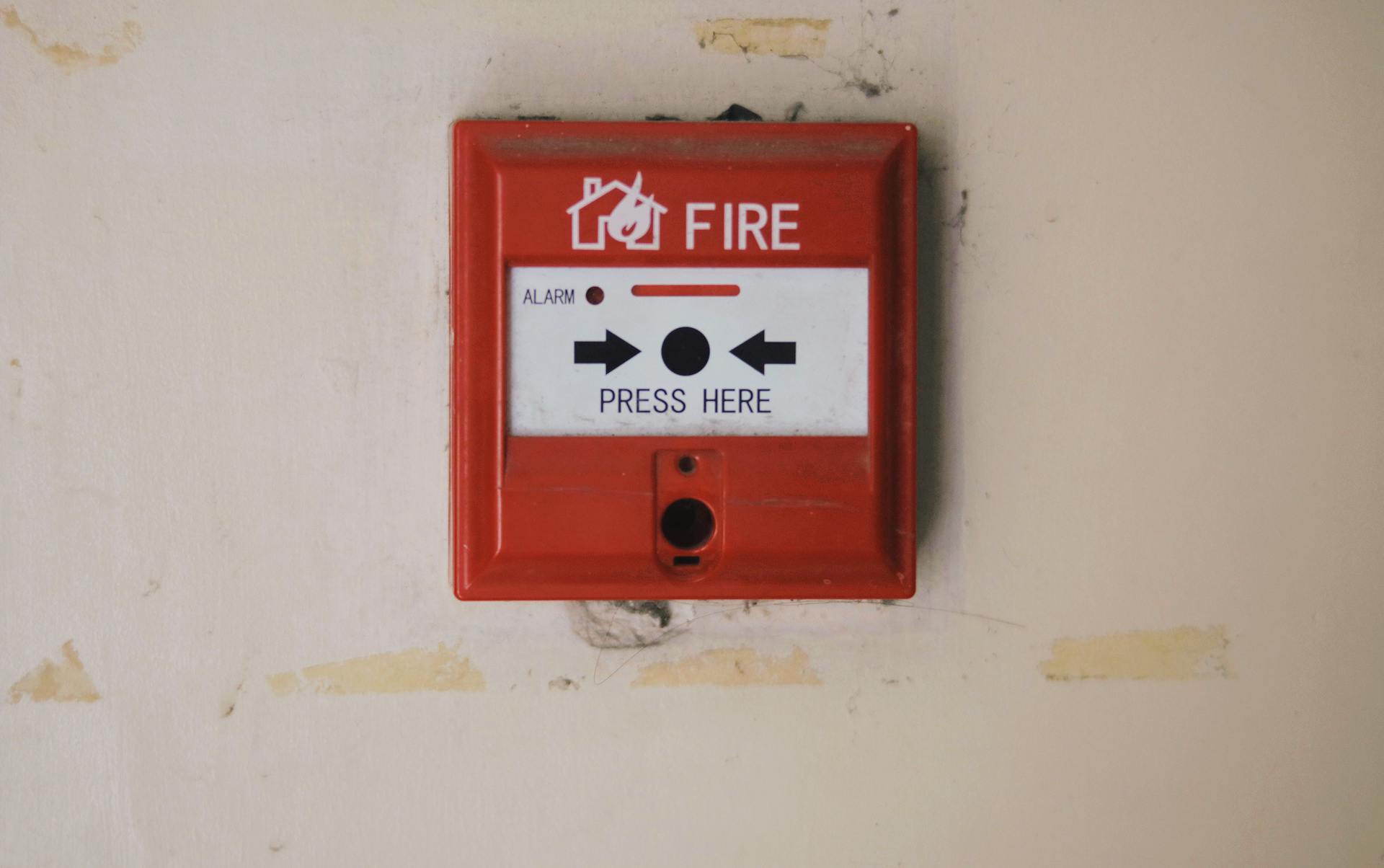
Explosive detection dogs undergo a comprehensive training process that involves teaching them to detect and identify various types of explosives.
This training typically begins with a foundation of basic obedience skills, such as sitting, staying, and walking on a leash.
Dogs are then introduced to the scent of explosives, starting with a controlled and gradual exposure to increase their confidence and sensitivity.
Their ability to detect explosives is assessed through behavioral evaluations, where their reactions to various scents are observed and recorded.
Discover more: Can Service Dogs Detect Seizures
Detection Dogs
Detection dogs are highly trained canines that use their incredible sense of smell to detect explosives.
Their incredible sense of smell is due to the fact that they have up to 300 million olfactory receptors in their noses, compared to only 6 million in humans.
Detection dogs are trained to detect the scent of explosives, which can be found in various forms such as vapors, liquids, or solids.
They can detect the scent of explosives even at very small concentrations, often as low as a few parts per billion.
Detection dogs are trained to work in a variety of environments, including airports, public events, and government buildings.
Their keen sense of smell allows them to detect explosives even in crowded areas with many distractions.
A different take: Detection Dog Training
Training and Tactics
Explosive detection dogs undergo rigorous training to ensure they can detect and locate explosives in various environments. This training is comprehensive and continuous, with teams receiving training throughout the year to maintain and advance proficiency.
TSA sources their canines from the Department of Defense Military Working Dog program and uses breeds such as Belgian Malinois, German Shepherd, and Labrador Retriever for explosive detection work. The canines are trained at TSA's Canine Training Center in San Antonio, Texas, and undergo a 10-week or 12-week training course depending on their role.
The training is designed to be as realistic as possible, with consideration for the safety of the canine, handler, site personnel, and guests. Trainings will not take place at any locations where it might interfere with the duties of site personnel. The goal is to find hidden explosives in a defined area, and the dog must be able to find the explosive in a realistic environment and meet the challenge of searching systematically.
Here are the certification standards used by Constellis:
- North American Police Work Dog Association (NAPWDA)
- International Police Work Dog Association (IPWDA)
- TSA Third-Party Canine (3PK9- Cargo)
- Department of Defense (DoD)
- Department of State (DoS)
- United Nations
Behavioral Assessments
Behavioral assessments are a crucial part of evaluating working dogs, particularly those used for explosives detection.
Most assessments use traditional behavioral tests consisting of sub-tests to measure aspects of temperament. These tests can be challenging to compare across groups due to a lack of standardization in terminology, test quality, and variables measured.
Subjective rating methods are often used to score behavioral tests, where an observer makes a judgment of global behavior on a Likert-type scale. This method can be prone to bias.
Coding methods, on the other hand, involve quantifying specific instances of behaviors, such as barking or cowering, which can be more objective. Some studies have found consistencies across rating and coding methods, but the optimal method may depend on the situation.
The majority of working dog assessments use these traditional methods, but they have limitations. The article highlights the need for more standardized and objective methods to evaluate behavioral characteristics in working dogs.
Preventive Tactics

Preventive Tactics are a crucial part of Explosive Detection Dog (EDD) teams' work, allowing them to detect or quickly rule out the presence of dangerous materials and minimize disruptions to customers.
EDD teams use various tactics to detect explosives, including training exercises that simulate real-world scenarios. These exercises can be designed in different ways, such as searching inside or outside areas, vehicles, lockers, or dressing rooms.
The goal of these exercises is to find hidden explosives in a defined area, and the dog must not only be able to find the explosive but also search systematically. This requires cooperation between the dog and its handler.
Some common tasks for detection dogs include checking cargo for explosives, which requires a detailed examination of objects. The presence of other odorous substances can make the detection of explosives even more difficult. These tasks can be designed according to the desired scenario, such as:
- Multiple boxes (cargo scenario)
- Single piece of luggage (bomb alert)
- A row of backpacks/pieces of luggage (“regular” inspection)
These exercises help EDD teams prepare for real-world scenarios and improve their ability to detect explosives.
Comprehensive Training

Comprehensive training is a crucial aspect of our training and tactics. Our teams undergo rigorous training to ensure they're proficient in their assigned programs.
This training is not a one-time event, but rather an ongoing process that tracks core progression and operational preparedness. Our EDD teams receive continuous and comprehensive training throughout the year.
We use a nationally recognized third-party certification program to ensure an objective certification process. This program is accredited and recognized by various organizations, including the North American Police Work Dog Association (NAPWDA) and the International Police Work Dog Association (IPWDA).
Our certification standards are rigorous and include various recognized programs such as the TSA Third-Party Canine (3PK9-Cargo) and the Department of Defense (DoD). We also certify our teams to work with the Department of State (DoS) and the United Nations.
Here are some of the layers of our in-service reinforcement training:
- Daily and weekly proficiency training
- Formal training sessions
- Monthly review of training records and usage report for accuracy
- Quarterly validations
These trainings are conducted in realistic environments, considering the safety of the canine, handler, site personnel, and guests. We avoid training at locations that might interfere with the duties of site personnel.
Cognitive Measures
Cognitive Measures play a crucial role in determining a detection dog's success. Researchers have applied various measures of cognitive ability to evaluate working dog suitability.
Measures of socio-cognitive abilities have indicated that social communicative behaviors are related to detection dog trainability. This means that a dog's ability to understand and respond to social cues is essential for effective training.
Inhibitory control, problem-solving, and short-term memory are all non-social cognitive abilities that have been found to be predictive of working dog performance. These skills enable a dog to focus, learn, and remember critical information.
Assessments of cognitive abilities have shown promise as valuable complementary measures to traditional evaluations for improving the selection process. By considering a dog's cognitive strengths and weaknesses, trainers can create more effective training plans.
Take a look at this: Gluten Detection Dog Training
Canines and Training
The canines used by TSA are sourced from the Department of Defense Military Working Dog program and are trained at the TSA's Canine Training Center in San Antonio, Texas.
TSA uses a variety of breeds for explosive detection work, including Belgian Malinois, German Shepherd, German Shorthaired Pointer, German Wirehaired Pointer, Golden Retriever, Labrador Retriever, and Vizsla.
There are two types of explosive detection canines: Conventional Explosive Detection Canines (EDCs) and Passenger Screening Canines (PSCs). EDCs undergo a 10-week training course and are trained to recognize explosive odors coming from baggage and vehicles.
PSCs, on the other hand, undergo a 12-week training course and are trained to recognize explosive odors on passengers, as well as odors from objects.
TSA operates 372 canine teams, each consisting of a Transportation Security Specialist - Explosive Detection Canine Handler (TSS-EDCH) and a canine.
A different take: Detection Dog
Explosive Detection
Explosive detection dogs are trained to detect a wide range of explosive materials, including TNT, C-4, and dynamite.
These dogs can detect explosives in various forms, such as solid blocks, liquids, or powders. Their sense of smell is incredibly powerful, allowing them to detect tiny amounts of explosive material.
Their training involves exposing them to different scents and environments, teaching them to distinguish between explosives and non-explosives. This process can take several months to a year or more.
These dogs can detect explosives in various situations, including in luggage, vehicles, and buildings. They can even detect explosives that have been hidden or disguised.
Their accuracy rate is impressive, with some dogs detecting explosives 99% of the time.
Working with Detection Dogs
Working with detection dogs requires careful planning and execution. UNOPS developed an Explosive Detection Dog Quality Standard to ensure safe and effective operations for teams that work with explosive hazards.
A team from UNOPS spoke to Walyuba Paul, an explosive detection dog handler in Mali, to gain insight into the importance of this standard. Explosive detection dogs like Walyuba's team are trained to detect and identify explosive hazards.
To work effectively with detection dogs, handlers must understand their strengths and limitations. Walyuba Paul is an example of a skilled handler who works with his team to ensure safe operations.
UNOPS' Explosive Detection Dog Quality Standard is a crucial tool for teams working with explosive hazards. The standard ensures that detection dogs are properly trained, handled, and cared for.
Broaden your view: Is It Safe to Take Dogs to the Dog Park
Training of Scenarios
Explosive detection dogs undergo rigorous training to prepare them for real-world scenarios. They are trained to detect explosives in various environments, including inside and outside areas.
Their training is designed to simulate realistic situations, such as searching for explosives in vehicles, lockers, and dressing rooms. This helps them develop their skills in finding hidden explosives in a systematic and efficient manner.
The cooperation between the dog and its handler is also a crucial aspect of their training. By working together, they can effectively search for explosives and respond to potential threats.
To simulate real-world scenarios, trainers use various tasks, such as checking cargo for explosives. This requires a detailed examination of objects, which can be challenging due to the presence of other odorous substances.
Trainers design these tasks to mimic different scenarios, such as searching multiple boxes, a single piece of luggage, or a row of backpacks or luggage.
Here are some common tasks used in training explosive detection dogs:
- Multiple boxes (cargo scenario)
- Single piece of luggage (bomb alert)
- A row of backpacks/pieces of luggage (“regular” inspection)
Conclusions
Explosive detection dogs have proven to be an effective tool in preventing terrorist attacks and saving lives. They are highly trained to detect a wide range of explosives, including homemade bombs.
Their keen sense of smell can detect minute amounts of explosive materials, often before they are even visible to the human eye. This is because they can sniff out the unique scent of these materials, which is often undetectable to humans.
The use of explosive detection dogs has been shown to be a cost-effective and efficient way to screen large crowds and areas for explosives. In fact, the cost of training and maintaining a single dog is often significantly lower than the cost of a single security scanner.
Their ability to detect explosives in real-time allows them to respond quickly and effectively in emergency situations. This is crucial in preventing catastrophic events from occurring.
These dogs are also highly portable and can be easily transported to different locations, making them ideal for use in a variety of settings.
Frequently Asked Questions
How long does it take to train an explosive detection dog?
Training an explosive detection dog typically takes 2-4 months, but their skills require ongoing testing and retraining throughout their career.
Sources
- https://www.constellis.com/services/k9-security-services/edd/
- https://www.frontiersin.org/articles/10.3389/fvets.2020.00597
- https://www.unops.org/news-and-stories/stories/explosive-detection-dogs
- https://en.wikipedia.org/wiki/National_Explosives_Detection_Canine_Team_Program
- https://www.ict.fraunhofer.de/en/comp/em/spuerhundetraining.html
Featured Images: pexels.com


